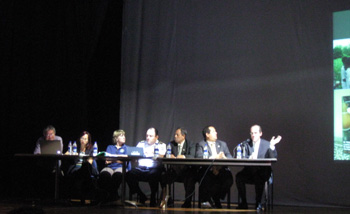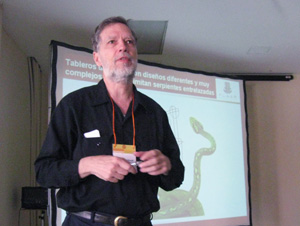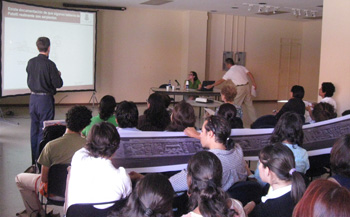In October 28 thru 30 of this year, was celebrated the III Central American Congress of Archaeology in El Salvador, titled “Frontiers, regions and cultures in Pre-Columbian Central America”, taken place in the Museo Nacional de Antropología –MUNA-, “David J. Guzmán”, with the support of the Consejo Nacional para la Cultura y Arte –CONCULTURA-, from El Salvador.
The themes of this congress were focused on the cultural changes that took place from the influences and socio-cultural processes in Mesoamerica and the Andean region during the Pre-Hispanic epoch.
Thanks to the archaeological investigations, it has become possible to know the similarity and cultural diversity that exists in Mesoamerica. And, as stated by the members of the organizer committee, of the third Congress of Archaeology, they contributed to the reflection about the theoretical and methodological development of the investigations that have been made in the region.
In the frame of the congress there were several presentations of the results and advances in the investigations about common issues related with archaeology, made during the last decade, in several countries that make part of the Mesoamerican region, contributing to make a wider perspective and to gain knowledge of all the assistants, investigators, students and general public.
The themes that were expose were divided in three aspects:
• Cultural zones
The presented papers gave the result of archaeological excavations, ceramic analysis, exchange relationships in Mesoamerica, diachronic changes, archaeo-astronomical elements, among others topics.
• Conservation and restoration
Identification of the vegetable covertures en the Pre-Hispanic architecture, architecture and conservation, registry and conservation of cave or rock painting, proposals of techniques and procedures of alternative restoration, archaeology in social sciences, oral traditions and social archaeology.
• The illicit traffic of cultural goods in Central America
The archaeological patrimony, illicit traffic, conservation and teachings inside the community, and reparation of Pre-Hispanic Mayan art.
FLAAR Mesoamerica also participated with the lecture “El Patolli: un juego prehispánico practicado en Mesoamerica. Breve reseña bibliográfica sobre las connotaciones del juego y las evidencias en el area maya” (In English: Patolli: a Pre-Hispanic game practiced in Mesoamerica. Brief bibliographical review about the connotations of the game practiced in Mesoamerica), presented by Dr. Nicholas Hellmuth and Antonieta Cajas.
The Patolli was a Pre-Hispanic game that lasted during many years and was registered through the archaeological evidence, in the Spanish chronicles and codex of the diverse cultural zones of Mesoamerica. Consists in a board with several squares, represented in several forms and variants, some drawn, painted or made by incision in patios, walls and floors of stucco of big Pre-Hispanic temples, even in petroglyphs, some in small sites dedicated to agriculture. Several authors have consider the patolli as an recreational activity and as a game associated with astronomical activities. Latter on, you can find the complete article on our site.
 |
|
Round table about the Illicit Traffic of Cultural Heritage. Archaeologists and representatives from El Salvador, Interpol and U.S. State Representatative
|
There were several lectures on archaeology of Guatemala, obviously most were on El Salvador and there was at least one lecture on Nicaragua. One or two scheduled topics on Mexico were cancelled because the speakers did not show up. I definitely would have enjoyed more lecture topics on Honduras and Mexico.
 |
|
The lecture by FLAAR was about the evidence of the Maya area Patolli. Nicholas explains the relation of snakes and the shape of some boards.
|
I especially enjoyed the lecture on Site Q (Peten). I also found the Conferencia Magistral on the Historia de Chocolate by Dr Rosemary Joyce to be informative. She pointed out that cacao was being grown and used in Mesoamerica before the Olmecs. This is a polite way of saying that we can’t really credit the Olmecs with cacao use any more (though of course the Olmecs may have popularized some aspects of it in their own time period). Of course Dr Joyce’s dates cast doubt on the common thought that cacao is a Mixe-Xoque word and spread by the Olmec and their neighbors. Here is definite food for thought (pun intended).
 |
|
Dr. Nicholas Hellmuth and archaeology student Antonieta Cajas in a lecture about Patolli. Nicholas shows the similarity of "skyband" that appears in the Patolli Uaxactun area and the Copan sculptures.
|
Held in the Museo Nacional de Antropologia “David J. Guzman”
 The museum is attractive, is in a pleasant peaceful part of the city, has friendly people in all parts of the museum. We were well attended in the bookstore, in the library, and inside the museum.
The museum is attractive, is in a pleasant peaceful part of the city, has friendly people in all parts of the museum. We were well attended in the bookstore, in the library, and inside the museum.
The Congreso Centroamericano de Arqueologia en El Salvador sponsors
Organizers
• Secretaría De Cultura De La Presidencia De La Repúbica
• Museo Nacional De Antropología "Dr. David J. Guzmán"-MUNA-.
• Ministerio De Turismo - MITUR
• Asociación Amigos Del Muna - AAMUNA
• Fundacion Nacional De Arqueología En El Salvador - FUNDAR
• Sistema De La Integración Centroamericana - SICA
Sponsors
• GPREMPER
• Embajada De Italia
• Embajada De Francia
• Secretaría De Relaciones Exteriores-Embajada De México En El Salvador
• Oficina De Asuntos Público, Embajada De Los Estados Unidos
• Coex, Café
• Grupo EJJE
... well as 33 other academic institutions in different countries of the world supported the organization of the Conference.
El Salvador is a friendly country
The taxi driver returned money to me saying I had paid too much. Please tell me in how many other countries would this happen !
We took the King Comfort bus from Guatemala City to San Salvador. It was pleasant, comfortable; they served better food than most airline snacks (and the seats even in the more economical section had more room than all airlines in economy glass).
Crossing the border was no longer a pain. Clearly El Salvador and Guatemala have learned that appearing backward and inefficient at the border is not good advertising.
Everyone at the hotel was pleasant. Same at the museum and in the restaurant. Great place to visit.
I should add, however, that this was the Zona Rosa, in the area of the Sheraton Hotel; other parts of the city might be a bit rough in comparison. But near the museum everything was safe, secure and friendly.
I highly recommend visiting El Salvador and the IV Congreso Centroamericano de Arqueologia en El Salvador in 2011, because it takes place every two years.
First posted November 10, 2009.































